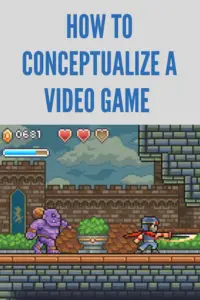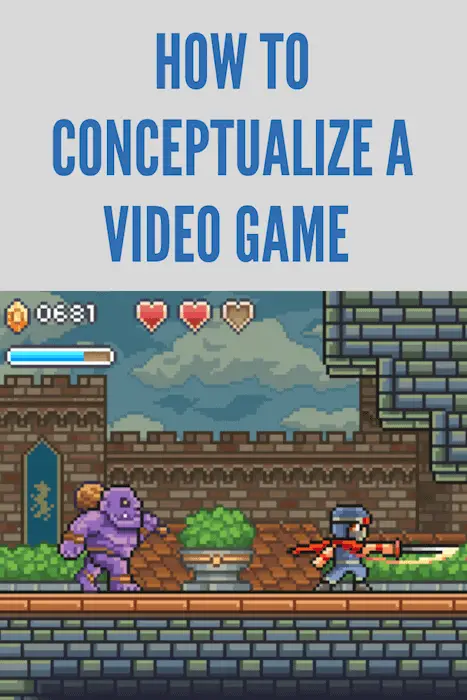How to Conceptualize a Video Game
Conceptualizing a video game is the process of taking an idea for a game and turning it into a clear course of action. The conceptualization process, when not handled correctly, can be a long and frustrating process for game designers. That said, here are the most helpful steps I’ve used in order to conceptualize a full game.
-
-
- Choose A Video Game Idea to Conceptualize
- Refine Your Video Game Idea
- Determine If You Can and Want to Create the Game You’ve Conceptualized
- Create a Prototype of Your Game Concept
- Iterate Your Game Concept Until Everything Feels Right
-
Conceptualizing a video game is hard work. It requires mental gymnastics, tons of creativity, and keeping track of dozens of ideas at the same time, but the results are well worth the effort. To help you in your game design process, let’s break down the areas mentioned above.
Step 1: Choosing A Video Game Idea to Conceptualize

Great ideas are the lifeblood of great video games. In order to evolve an idea into a full-fledged game, you must first have an idea that’s worthy of pursuing. As any game designer knows, this is easier said than done. But not to worry! There are a few tricks for getting the ideas flowing.
Finding Inspiration for Your Game
Stay Alert – Ideas Can Come from Anywhere
As you’re trying to come up with a great idea for your game, keep in mind that inspiration can come from anywhere. Shift your mindset to begin looking for ideas in unusual places.
How could a mundane task you do every day be turned into a fun game experience? What types of interesting characters are in your life that might make good video game characters? What stories have you heard, or experiences have you had that could produce a unique experience for players?
Learning to keep your mind in a perpetual creative space will help you glean every last drop of inspiration from your environment.
Absorb Media that Inspires You
If your well of inspiration is running dry, one of the most likely reasons is that you’re not consuming enough inspiring media.
Find great books, comics, TV shows, movies, and games that pique your imagination and are tangentially related to the style of game that you’re interested in creating. In doing so, you’re bound to stumble into fresh ideas you can apply to your game.
Draw from What You Love
Don’t be afraid to shamelessly draw inspiration from the things that you love. Almost all creative work first finds inspiration from someone else’s creative work.
However, if you draw inspiration from someone else’s work of art, you should avoid completely knocking it off. Players can smell this a mile away and they don’t always take kindly to it.
Set Aside Time for Game Brainstorming Sessions
True deep thinking takes effort. Some of the best ideas come when you push away all distractions and simply think about the type of game you want to make.
For me, some of my best thinking is done as I’m going to sleep at night. I’ll let my mind drift around a subject and then quickly take note of any ideas with potential before I fall asleep.
15, 20, or 30 minutes each day of concentrated thinking can be all it takes to discover a game idea worth conceptualizing.
Learn to Recognize Good Ideas to Conceptualize for Games
After brainstorming for a while, you should hopefully have a decent-sized list of video game ideas. Now comes the process of sifting through those ideas for the diamond in the ruff. When I’m sorting through ideas for games, there are 3 questions I like to ask myself to help me weed out weak ideas.
1 – What’s the appeal of this game idea?
Another way to phrase this question would be, why would people want to play and keep playing your game? Is it because of the art, action, story, humor, emotional appeal, or unique game mechanics?
Just like pop songs have catchy hooks that everyone remembers, what is the “hook” of your game idea that people will remember and come back for?
2 – How is this game idea different than what’s already out there?
If it doesn’t look like your game is bringing anything new to the table, you might have trouble getting players to your table in the first place.
Why would players play a ripoff of another great game when they could just go play the original? Ask yourself if your game is unique. Does it do something fresh and give players an experience they can’t find elsewhere?
While it’s alright if not every aspect of your game is 100 percent unique, the core experience of it should be.
3 – Is this game idea something I would enjoy working on for the next few years?
The less experience you have, the longer it will take to create the game you envision unless you’re hiring out the areas in which you lack expertise. Before tackling a style of game I’ve never tackled before, I like to ask myself if the idea is something I will still be interested in 3 years from now. When the excitement has worn off, is the idea itself strong enough to keep me engaged?
Answering these questions about your game ideas will go a long way in helping you decide which one to pursue, however, here are a couple more tricks that might help your decision-making process.
Write Down the Ideas You’ve Had
Writing down your game ideas not only keeps you from forgetting them, but it also helps you think about them differently. You’ll be able to slowly add more ideas to your list, and draw lines between ideas that you didn’t think were connected before.
Piecing together a few okay game ideas might just be the recipe for a great game idea, so this is where making a list can help.
Let Your Video Game Ideas Incubate
Once I’ve found a handful of ideas that I’m interested in, I like to let them incubate in my head for a while. When a good game idea is in your head, you’ll start finding ways to expand upon it even when you’re not intentionally thinking about it.
For this purpose, I recommend giving yourself a few weeks to allow your game ideas to expand before selecting the one that you will work on. The best one will usually be the one you can’t stop thinking about.
Step 2: Refining Your Video Game Concept

At this stage, you should have an idea that you’re ready to work with. So far, you likely only have a loose idea of your game. Your goal at this point is to refine your idea to its core and determine a clear direction for it.
There are numerous ways you can go about this, but here are a few that I find the most helpful.
Create a Game Concept Document
A game concept document is like a blueprint for your game. When it comes to stylistic choices, character personalities, story, and game mechanics, your game concept document is the final word.
Game concept documents are particularly important if you’re planning on working with a team to create your game. This document will serve as a reference for everyone on the team so that the game doesn’t feel discombobulated when it’s finished.
If you’re creating a game solo, you might not need to be quite as thorough in your game concept document, but at the minimum, you should still determine the following things and have them written down to reference.
For the initial conceptualizing process, keep things brief in your document. Once you’ve determined that you’re committed to the idea you can come back and fill it in more.
How Do Players Win and What Do They Do To Achieve It?
The first thing you should decide, is how do your players win? Are they simply trying to reach the exit of a level, or are they required to complete specific tasks before progressing? By determining what success looks like for your players, you’ll be able to think more clearly about the steps that they might need to get there.
Which leads us to the second half of this question. What must players do to win, or what game mechanics must they use to win? Can players run, jump, dash, climb, or fly? Do they have special powers of any kind that they’ll need? Are there puzzles in the environment they must solve, or bosses they have to defeat?
Write out clear, simple, but thorough answers to these questions in your document.
What Feelings Do You Want to Produce In Your Players?
Knowing the feelings you want your player to have from the beginning of the game design process will allow you to shape your game accordingly. Ask yourself if the player should feel stressed, relaxed, vulnerable, empowered, or any other range of emotions, and write them down to reference in your document.
What’s the Story of the Game?
Write a brief synopsis of the story behind the game you envision. At this stage, try to keep it short and only address the main conflicts and goals that the player is working towards throughout the game.
What’s the Appeal of the Game?
When people see a trailer for your game, what should the appeal for them be? Is it the art, story, or action? Determine what the main selling points are for your game that you’ll want to portray in your marketing materials further down the road.
Who is Your Target Demographic?
Who are you making the game for? Young novice gamers, older experienced gamers, or are you trying to make a game that appeals to everyone to some extent.
What genre of game are you creating, and what are the unique traits of the demographic that typically plays that genre? To answer this question, you might need to do some research, but the findings will improve your chances of creating a successful game.
There’s certainly more you’ll want to add to your game concept document as you progress, but having the answers to each of these questions will have you well on your way to deciding whether or not this is the game you want to make.
Step 3: Determine If You Can and Want to Create the Game You Conceptualized

Now that you have a firm idea of the direction you would like to take your game, it’s time to start examining the technical aspects of creating a video game to determine whether or not the project is feasible.
Here are the main areas that you’ll want to consider before you begin creating your game.
Examine the Technicalities of Your Game to Determine If You’re Capable of Pulling it Off
This is where you’ll need to dive into the practical nitty-gritty aspects of your game to decide if it’s something you’ll be able to make. Here are the questions to answer at this stage:
-
-
- What platform or platforms will the game run on?
- What are the graphical requirements for the art style you have planned?
- Do you have the expertise and experience to make this game alone?
- Can you learn what you need to learn in order to make this game?
-
Examine the Market for Your Game
If your goal is to make money with your game, you should do thorough research on the market for your game. The reason being, you could make the game of your dreams, but if there isn’t a big enough market for it, then you’ll never make very much money from it.
If you’re creating a game more as a hobby rather than for financial success, then this step is optional.
Think About the Time and Finances Required for Your Game
The Time Factor
The fact of the matter is, it can take a while to create a quality video game. Especially if this is your first rodeo and you plan on doing it alone. That said, you should think realistically about the time it might take in order to complete your game.
How many hours will you need to work each day? Do you have that time available outside of your normal job? If not, how can you make more time?
It’s been said, people can always find time for the things that are important to them. If creating video games and earning a full-time income off of them is something you’re passionate about, don’t let time constraints hold you back.
View your time working on your game as an investment in the future. Work hard today so that you can live better 5, 10, or 20 years from now. No one’s going to force you to pursue your passion. It’s a choice you have to make yourself.
The Money Factor
From the very start of your game, it’s imperative that you think big picture financially. Finances can make or break a game, so having an idea of the costs involved upfront can save you some heartache down the road.
The financial burden of creating your game will vary depending upon the tools you plan on using. Thankfully, there are numerous free tools available for creating games, however, these free tools often come with restrictions that can make it difficult to take the steps you want to with your game. Whether that be publishing to numerous platforms, or simply being able to collaborate with other people.
Starting out, it might be tempting to use a free tool that allows you to publish 1 or 2 platforms, but this might hurt your finances later on if you’re unable to publish to the platform where the majority of your target demographic is playing or the tool demands you give them a large cut of your profits.
Before starting work on your game, shop around to make sure that you’re using the right tools to fulfill your longterm vision.
If there are areas of your game you plan on hiring out, such as music, art, and voice acting, research to determine how much these areas will cost so that you can budget accordingly.
My recommendation is to create a spreadsheet where you write at all of the expenses that your game will require, in addition to your regular living expenses.
If the numbers aren’t adding up so that you can work on your game, start looking for expenses you can cut, like Netflix, or the gym membership you only use once in a blue moon.
Step 4: Create a Prototype of Your Game Concept
The prototyping stage is where you get to see your video game concept in action. The focus of your prototype should be upon the core game mechanics rather than the granular details and story aspects of your game.
The purpose of a prototype is to get a taste for how the game will feel and flow for players.
While testing a prototype, you should ask yourself these questions:
-
-
- Do the game mechanics work well with one another?
- Does the game feel balanced?
- How does the navigation system feel?
- Are the controls and mechanics overly complicated?
- Do all of the features truly add to the feeling and experience you want to create?
- What do the people you trust think about the prototype?
-
If you’re not able to create a full-fledged prototype for whatever reason, you might consider testing your game by converting it into a board game or creating a simple 2D version that allows you to experience how the core mechanics feel in conjunction with one another.
Step 5: Iterate Your Game Concept Until Everything Feels Right
With the knowledge you’ve gained from the prototyping phase, you can now return to your game concept document and begin making corrections and additions as needed.
Once you’ve determined the areas you need to improve, you can repeat the process of integrating them into your prototype until everything feels just right.
When you have a prototype experience that will lend itself well to a full game, you’re ready to really start working on your project!
For more game design resources, you can head here to check out all of my recent articles.


